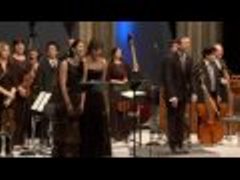Pergolesi - Stabat Mater
Pergolesi - Stabat Mater

1. Stabat Mater dolorosa – Grave 2. Cujus animam gementem – Andante amoroso 3. O quam tristis et afflicta – Larghetto 4. Quae moerebat et dolebat – Allegro 5. Quis est homo – Largo 6. Vidit suum dulcem natum – A tempo giusto 7. Eja mater fons amoris – Andantino 8. Fac ut ardeat cor meum – Allegro 9. Sancta mater, istud agas – A tempo giusto 10. Fac ut portem Christi mortem – Largo 11. Inflammatus et accensus – Allegro 12. Quando corpus morietur – Largo assai Johannette Zomer – soprano Maarten Engeltjes – countertenor Concerto Köln Peter Dijkstra – conductor Concertgebouw Amsterdam, 25 march 2012
Pergolesi's Stabat Mater, which depicts the moving image of Mary grieving at the foot of the cross, is highly dramatic in its narrative and musical style. The sequence of Latin verses was originally composed by Jacobus de Benedictis in the 13th century, in commemoration of the sorrows of the Virgin Mary. The work unfolds in a series of twelve solos and duets for two high voices with string accompaniment. Alessandro Scarlatti (1660-1725), also a native Neapolitan composer, used the same forces in his Stabat Mater written around 1700. It is believed that Pergolesi's setting was commissioned by the Duke of Maddaloni to replace Scarlatti's work, which was considered a little old fashioned for the nobleman's contemporary taste. Pergolesi's version clearly attests to his abundant melodic gifts, a contrapuntal ingenuity, in addition to a demonstration of profound harmonic skills. The frequent suspensions and the gradual blending of one chord into another contrast greatly with the cleaner harmony changes favoured by the more austere North European approach of Buxtehude, Bach and others. Following Pergolesi's death, the Stabat Mater became one of the most widely disseminated and frequently printed manuscripts of the 18th century. Johann Sebastian Bach's German setting of Psalm 51 (Tilge, Höchster, meine Sünden), a tribute to Pergolesi in the form of a musical parody, is an example of the numerous arrangements and adaptations it inspired. --- Ashley Solomon & Jennifer Morsches, linnrecords.com
download (mp4 @198 MB):
Zmieniony (Niedziela, 18 Marzec 2018 10:35)








